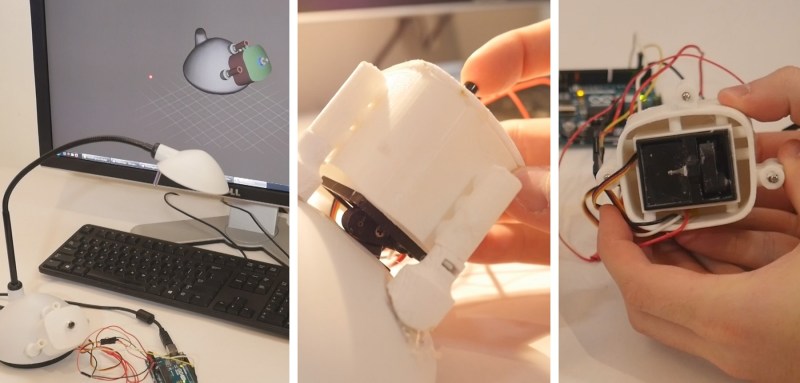On the Starship Enterprise, an engineer can simply tell the computer what he’d like it to do, and it will do the design work. Moments later, the replicator pops out the needed part (we assume to atomic precision). The work [Raf Ramakers] is doing seems like the Model T ford of that technology. Funded by Autodesk, and as part of his work as a PhD Researcher of Human Computer Interaction at Hasselt University it is the way of the future.
The technology is really cool. Let’s say we wanted to control a toaster from our phone. The first step is to take a 3D scan of the object. After that the user tells the computer which areas of the toaster are inputs and what kind of input they are. The user does this by painting a color on the area of the rendering, we think this technique is intuitive and has lots of applications.
The computer then looks in its library of pre-engineered modules for ones that will fit the applications. It automagically generates a casing for the modules, and fits it to the scanned surface of the toaster. It is then up to the user to follow the generated assembly instructions.
Once the case and modules are installed, the work is done! The toaster can now be controlled from an app. It’s as easy as that. It’s this kind of technology that will really bring technologies like 3D printing to mass use. It’s one thing to have a machine that can produce most geometries for practically no cost. It’s another thing to have the skills to generate those geometries. Video of it in action after the break.
















That’s a paradigm shift in home automation. The system is not merely consisting of building blocks that do different tasks, but a development system to create the physical device only based on function. In a way it emulates nature’s way of adapting to environmental demands. But this guy has no girlfriend!
Doubtful, nothing of value comes from Belgium.
I’ve had some kickass Belgian beer.
Btw, RetroFab is friggin’ awesome.
You were probably sarcastic, but just in case:
Robert Cailliau: World Wide Web and the first web browser macwww
Ferdinand Peeters: contraceptive pill
Ingrid Daubechies: JPEG compression
Adolphe Sax: Saxophone
Edward De Smedt: modern asphalt
Joan Daemen & Vincent Rijmen: Rijndael (AES)
I think for such a small country that is quite alot.
beer
french fries (should have been belgian fries, because that’s were they actually originated)
Bruges is very popular for it’s lace
And of course waffles
This is a really interesting idea and while it might be (in a way) simple, it looks quite like a large leap for the general public. I’m going out on a limb and saying that most people would prefer a “out-of-the-box” automated toaster rather than going through various steps to retrofit to their current toaster. This retrofitting certainly fills a gap but i wouldn’t be surprised if large companies catch wind of it and start producing automated appliances.
Still, i wouldn’t mind retrofitting a heap of appliances around my place, and the grouping function is amazing. Only real flaw is the mounting brackets, but get a designer on board to pretty that up haha
While this is superb as a research subject, it leaves a zillion questions behind, and also a zillion open corners and rough edges. The future of this kind of tech may be amazing, but there is a question that needs to be answered first: why not design a brand new device with such capabilities already built in?
Excellent question. Smart appliances in the future can indeed have built-in support for end-user reprogramming of its controls. Besides changing the behavior of appliances, RetroFab however, also allows for changing the appearance and thus the ergonomics of devices. Using RetroFab’s modular toolkit, caregivers can for example put controls in place which require only low-force or little dexterity to make devices easier to operate by elderly or impaired individuals. For these situations, designing a brand new device, tailored to the needs of specific users with special needs, would be extremely costly.
Besides, RetroFab turns outdated appliances into smart appliances which are often expensive and will eventually also be outdated.
I would give my left kidney (I’m cool with just the right one) to automate my toaster like this in te morning.
Power???